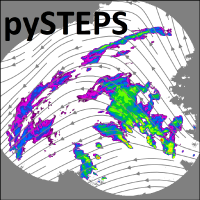pysteps.feature.blob.detection#
- pysteps.feature.blob.detection(input_image, max_num_features=None, method='log', threshold=0.5, min_sigma=3, max_sigma=20, overlap=0.5, return_sigmas=False, **kwargs)#
Interface to the feature.blob_* methods implemented in scikit-image. A blob is defined as a scale-space maximum of a Gaussian-filtered image.
- Parameters:
input_image (array_like) – Array of shape (m, n) containing the input image. Nan values are ignored.
max_num_features (int, optional) – The maximum number of blobs to detect. Set to None for no restriction. If specified, the most significant blobs are chosen based on their intensities in the corresponding Laplacian of Gaussian (LoG)-filtered images.
method ({'log', 'dog', 'doh'}, optional) – The method to use: ‘log’ = Laplacian of Gaussian, ‘dog’ = Difference of Gaussian, ‘doh’ = Determinant of Hessian.
threshold (float, optional) – Detection threshold.
min_sigma (float, optional) – The minimum standard deviation for the Gaussian kernel.
max_sigma (float, optional) – The maximum standard deviation for the Gaussian kernel.
overlap (float, optional) – A value between 0 and 1. If the area of two blobs overlaps by a fraction greater than the value for overlap, the smaller blob is eliminated.
return_sigmas (bool, optional) – If True, return the standard deviations of the Gaussian kernels corresponding to the detected blobs.
- Returns:
points – Array of shape (p, 2) or (p, 3) indicating the pixel coordinates of p detected blobs. If return_sigmas is True, the third column contains the standard deviations of the Gaussian kernels corresponding to the blobs.
- Return type:
